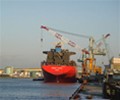Activities within the maritime industry are mostly dominated by people who interact with technology, environment and organisational factors. Advancement in technology has significantly improved maritime safety. The injection of sophisticated technology in the marine industry has impacted tremendously on human performance. Improvements in ship design and navigation aids have reduced manning levels and the frequency and severity of shipping accidents. Also, technology has improved productivity in shipping in 3 main areas namely: development of steam power on merchant ships, port performance and metallurgical innovations. With increasing cargo capability, steam powered ships were able to navigate safely, while metallurgical improvements of hulls provided larger, stronger and high capacity merchant ships.
High productivity of shipping in port can be achieved through better performance of the port in various stages including cargo handling and it could be as a result of provision of excess facilities. Whenever, traffic volumes are in excess of capacity, the port will be under very strong pressure from its main users to increase capacity immediately as it is the case with most ports in Nigeria. Although, some ports are underutilised, it may however be argued that the visible inefficiency in Nigerian ports is not due to inadequate provision of facilities but bureaucratic bottlenecks, and inconsistent government policies. Some may equally argue that inefficiency in Nigerian ports is as a result of lack of appropriate technology, inadequate skill and knowledge on how to manage ports. Whatever the argument, the Federal Government of Nigeria has concessioned the ports to private organisations to enable attainment of efficiency through time reduction of cargo clearance. Increased productivity is attainable either through better ways of working or improved technology but will not engender safety at the ports unless port workers’ safety culture is deep rooted in excellence.
Many developed nations have taken steps to provide certain margin of safety in the marine industry through deliberate government policies. This helps to increase productivity and also enhance overall capacity. The use of sophisticated cranes and other devices to handle cargo coupled with an assembly of individuals with skills, competencies and knowledge will influence productivity and safety. It has always been said that “Nigerians are hardworking and that the country is well endowed with human resources”. This is debatable as hard work does not automatically translate to productivity but rather production. The gifted human resource hypothesis will only be valid in terms of productivity when most Nigerians operating in the nation’s marine industry are educated and possess skills necessary to enhance safety.
It is to be stressed however, that safety margin is not free of cost as most developing nations consider it inappropriate and economically unprofitable to invest in such additional capacity especially when resources are scarce. Experience has shown that “shipping companies within or outside Nigeria with high levels of safety report have low accident figures, low replacement rates for crews, less crew absence and high productivity”. The best –in-class shipping companies are therefore the safest and most productive.
The environment can also contribute to maritime safety. By environment, consideration is not only given to weather and other physical factors but also to regulations and economic issues. Physical factors such as extreme temperature conditions affect human performance in the maritime environment. Importantly, high sea state and ship vibration cause stress and fatigue for seafarers. When stress and fatigue sets in, individual’s perception of the elements within the maritime environment is affected. A review of 100 shipping incidents by a few maritime experts revealed “that cognitive problems were responsible for 70 percent of human errors”. Between 1987 and 2000, human error in maritime accidents reports of 8 countries examined revealed “that 71 percent of all human error types in ships are occasioned by situation awareness”.
Organisational behaviour is the action and attitude of people towards each other and the organisation and its effect on performance. Organisational factors such as policies, crew size and training decision directly affect their workload and capabilities to perform safely and effectively. An organisational structure that is inflexible can inhibit effective team work, whereas safety culture can enhance it.Safety culture covers factors as diverse as the values and practices, organisational structure and outlook, and modes of behaviour of management and personnel towards sustaining safety and mitigating risks. Safety culture will be effective when leadership and staff keep safety and pollution prevention at the highest level of their safety priority list. Therefore safety culture is sustained through leadership commitment to establishing safety measuring performance and behaviour in order to mitigate risks to human, ships and the environment. Committed Leadership is essential in driving safety in an organisation and impacting on human performance.
Safer shipping in the marine industry requires ship owners and operators to have an effective safety culture. Studies have shown that a conscious attempt to practice sustained safety culture in a shipping organisation will give rise to reduction in man days lost because of accidents; reduction in fines for pollution incidents;reduction in insurance premiums; reduction in damage to cargo; reduction in sick leave and reduction in hospital bills.When safety culture is not imbibed in people, situation awareness will be below par. In other words, individual’s perception of the elements within the maritime environment will in most instances not match the reality. Accordingly, when perception does not match reality, there is likelihood of an accident arising from lack of communication, complacency, lack of knowledge, distraction, and lack of team work, fatigue and lack of resources. Others include stress, lack of awareness, lack of assertiveness, norms, and lack of work ethics.
Source: Business Day Online
Copyright Ships & Ports Ltd. Permission to use quotations from this article is granted subject to appropriate credit given to www.shipsandports.com.ng as the source.

